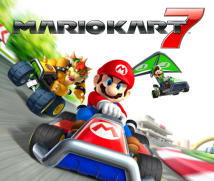3. Connecting Minds
Alright, now let’s talk about the characters. Ishikawa-san, what sort of dialogue happened between you and Retro?
We started with the task of making it so that characters of various builds could all ride in the same kart. In addition, this game has a new “flying” function, which means there’s a glider attached to the top of the kart, and we had to make it so that the characters’ heads wouldn’t bump into the glider. On top of that, the characters need to move energetically. We had Retro create animations for what it would be like to drive the course, the feel of throwing items, and what would happen after a crash. There were limits within which we had to do all this, and we had many discussions about how to make the characters energetic within those limits as Retro moved forward with their animation.
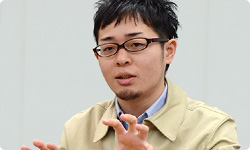
That must have been a very tall order! Vince-san, how did you tackle that problem?
(laughs) It was an interesting challenge. We had many different sizes of characters and we wanted to have very expressive animations for a lot of them. Often, we would put the glider on the top, and we would see the head go through the top... Ishikawa-san and myself went back and forth a lot on adjusting everything to fit just right, but it was definitely a fun and interesting challenge.
In the end, the characters do move energetically, and it seems completely natural, but you did have to overcome a lot of issues to make that happen.
We did. This time, we also had to put in the specs for the jump action 14, and making that a reality truly was a headache and a half. (laughs) For the jump actions, movements need to be even showier than normal, but when we started working on that feature, the characters were extremely close to bumping into the glider already. 14Jump action: One of the actions that happens during races in the Mario Kart series. Action commands performed after a jump will let the characters dash when they land on the ground again.
Ishikawa-san had a lot of patience with us and our animation team. That also went for the creation of the characters: every character that we made, we’d sit down with the character artists, and we’d think we’d gotten it just right, and we’d send it off hoping we’d gotten it right, and Ishikawa-san would point out one little thing that needed to be adjusted again and we’d say, “Aw, we missed it!”
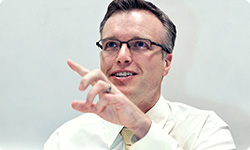
It seems like, ultimately, you all felt like one single group; almost as if the EAD team had a branch office in Texas. Ichijo-san, why do you think you managed that?
I think...it was probably all due to that first yakiniku party. (laughs)
(laughs)
Besides that, Retro also loves Mario Kart, and they were really enthusiastic about it. I think that may be the reason we were all oriented in the same direction, going the same way.
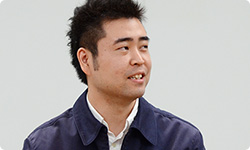
That sounds similar to the way you managed to make Donkey Kong Country Returns so well.
Ah, you’re right. Yes, it’s exactly the same.
I don’t know how we would have done it without Ichijo-san, to be honest. He was sending us screenshots of tools that were still in Japanese, with notes saying what the buttons did, and helping us not only translate text but also translate feeling and the goals we were trying to get. I left the project towards the end to work on other projects, and Bill Vandervoort who came in during the process was working with Ichijo-san very closely, and he had the same feeling.
Thank you!
Generally, people tend to think that interpretation means translating one word to another word, but what’s really important is connecting minds. Retro understood the fascination of Mario Kart from the beginning and felt that this was a job worth doing. Then, at the yakiniku party, each side lost its nervousness about the other, and every week after that we kept in constant back-and-forth contact, sharing the same awareness of the project. I think that’s the reason we were able to resolve the problems together.
(nodding together) Yes, that’s right.
There’s one other reason it went so well. Retro has three design sections - level design, art design and animation design - and I think the balance there was very good. This time, we requested that Retro perform the designs, and in general, my impression is that American level designers are well acquainted with 3D tools, and very skilled at using them when putting together courses. Miyamoto-san often tells us, “It doesn’t matter if it’s just a box or a miniature landscape. First see if it’ll be interesting if it moves.” And there are actually staff members who create such things at Retro as well. They think of all sorts of things and work in lots of ideas as they create the course. It happened that way on this game, too. They’d build things, then tear them down and build them again, and were really positive about working hard.
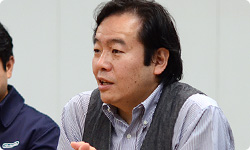
Listening to you now, it sounds as though Retro and the Mario Kart 7 team worked so perfectly together because Retro really used the experience they’d acquired in working on the Metroid Prime games and Donkey Kong Country Returns. What do you think, Tom-san?
Certainly, in our experience working with Nintendo and in coming to understand Nintendo philosophy through the years of working with the SPD group, that’s something that we’ve always tried to advance our knowledge of: the general feeling of how to make a Nintendo game. That carried over again in terms of finding out that EAD has the same philosophy. Even though we’d never worked together before, it felt as though we had.
Tanabe-san and Konno-san both learned about games from the same mentor, Miyamoto-san, so they probably share the same mindset about how to create and think about games. It seems as though the distance between the Retro staff and us has shrunk considerably. How many times did the Japanese staff go to Texas for meetings?
I went once, Morimoto-san went twice, and Ishikawa-san went once.
Let’s hear your impressions of Texas. Ichijo-san, you’ve known some of the Retro staff well for a while now, haven't you?
I’m quite close to the three who are with us today because I knew them before. This time I was also able to be in close communication with other staff members on site, so I had the opportunity to get closer to Retro as a whole. I was very glad about that.
I thought development at Retro’s studio looked very different from the way it does here, with the EAD team. At Retro, I thought every staff member’s room was really large. Each member had lots of things related to their hobbies in their own room; it looked like a really fun development studio.
The steak I had there was absolutely incredible, and I thought, “You know, I do believe I could live here!”
Yes. (laughs)
The air was dry, and it made for a comfortable working environment. But... Tanabe-san said “They have armadillos there!” so I looked for them, but, sadly, I never saw one. (laughs)
